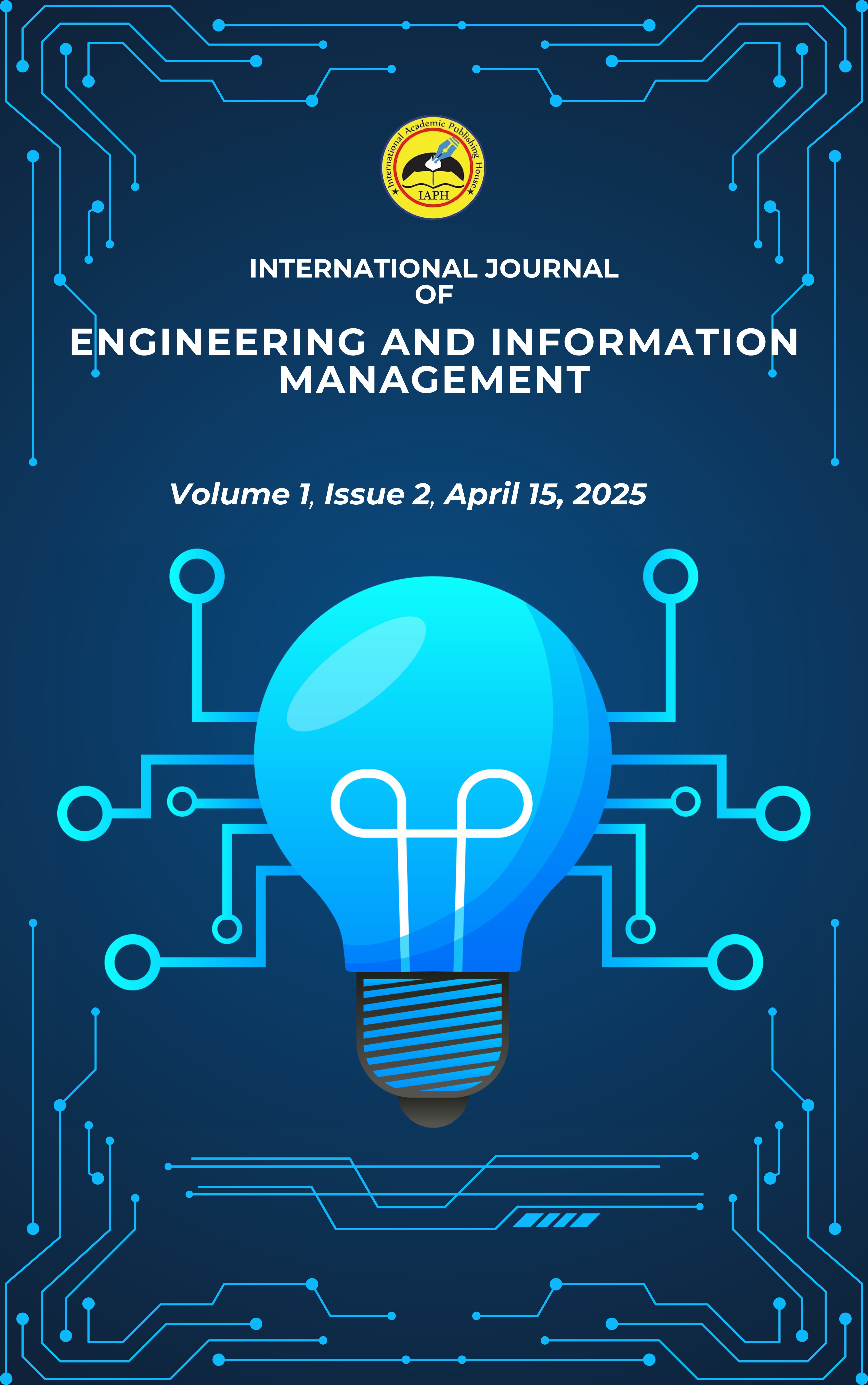Study of Dynamic Mechanical Properties and Microstructures of Aluminium 7075 T651 Alloy by using Split-Hopkinson Pressure Bar and Universal Testing Machine
DOI:
https://doi.org/10.52756/ijeim.2025.v01.i02.004Keywords:
Aluminium 7075 Alloy, Mechanical Properties, Microstructure, Split-Hopkinson Pressure Bar, Strain Rate, Yield StressAbstract
Aluminium 7075 T651 alloy is an advanced high-strength, precipitation hardened alloy extensively used in aerospace and automotive structural components due to its exceptional strength-to-weight ratio and superior fatigue resistance. A comprehensive evaluation of the Aluminium 7075 T651 alloy under quasi-static compression utilized the Universal Testing Machine (UTM) at room temperature followed by high strain rates between 1138–2534 s−1 and the lower strain rate of 10−4−1s through Split-Hopkinson Pressure Bar (SHPB). Microstructural changes were recorded by using Scanning Electron Microscope (SEM) after exposing the material. The SHPB apparatus compressed cylindrical specimens measuring 6 mm in height with a 6 mm diameter. The strain rate, withdrawal stress, and yield stress both escalated while the strain hardening exponent (n value) grew when compared to impact velocity test rates at high strain rates in contrast to slow strain rate tests. The microscopic analysis demonstrated grains of the Al matrix experienced elongation after the high strain rate test operation. The mechanical characteristics of Aluminium 7075 T651 strengthen dynamically due to microstructural variations and strain rate-dependent strengthening mechanisms. Research findings obtained from this study lead to beneficial data for designing and deploying this alloy in high-strain- rate applications to create
safer more efficient engineering components.
Downloads
References
Bassim, M. N. & Panic, N. (1999). High strain rate effects on the strain of alloy steels. Journal of Materials Processing Technology, 92–93, 481–485. https://doi.org/10.1016/s0924-0136(99)00248-4.
Bhat, K. U., Panemangalore, D. B., Kuruveri, S. B., John, M., & Menezes, P. L. (2022). Surface modification of 6xxx series aluminium alloys. Coatings, 12(2), 180. https://doi.org/10.3390/coatings12020180.
Bosneag, A., Constantin, M. A., Nitu, E., & Iordache, M. (2018). Friction stir welding of three dissimilar aluminium alloy: Aa2024, aa6061 and aa7075. IOP Conference Series: Materials Science and Engineering, 400, 022013. https://doi.org/10.1088/1757-899x/400/2/022013.
Brown, K. (1982). Factors influencing the fracture toughness of high-strength aluminium alloys. In Elsevier eBooks (pp. 765–771). Elsevier. https://doi.org/10.1016/b978-1-4832-8423-1.50125-5.
Cerutti, X. & Mocellin, K. (2014). Prediction of post-machining distortion due to residual stresses using fem and a massive removal approach. Key Engineering Materials, 611–612, 1159–1165. https://doi.org/10.4028/www.scientific.net/kem.611-612.1159.
Chen, Z., Chen, Z., Li, H., & Liu, J. (2020). Structure-material integrated design for a spacecraft rib. American Journal of Mechanical and Materials Engineering, 4(4), 81. https://doi.org/10.11648/j.ajmme.20200404.11.
Emmanuel, A., Fayomi, O., & Akande, I. (2021). Aluminium alloys as advanced materials: A short communication. IOP Conference Series: Materials Science and Engineering, 1107(1), 012024. https://doi.org/10.1088/1757-899x/1107/1/012024.
Guttmann, M. & Dubost, B. (2006). The research programme contract “precipitation”: what for? – the preliminary analysis of needs by the industrial partners. Advanced Engineering Materials, 8(12), 1215–1219. https://doi.org/10.1002/adem.200600179.
Hopkinson, B. (1914). X. a method of measuring the pressure produced in the detonation of high, explosives or by the impact of bullets. Philosophical Transactions of the Royal Society of London. Series A, Containing Papers of a Mathematical or Physical Character, 213(497–508), 437–456. https://doi.org/10.1098/rsta.1914.0010.
Lee, O. S., Hwang, S. W., Choi, H. B., Kim, D. H., & Kim, H. M. (2009). Dynamic deformation of aluminium alloys at high temperature by using shpb techniques. In DYMAT 2009 - 9th International Conferences on the Mechanical and Physical Behaviour of Materials Under Dynamic Loading. https://doi.org/10.1051/dymat/2009063.
Lewis, J. L. & Goldsmith, W. (1973). A biaxial split hopkinson bar for simultaneous torsion and compression. Review of Scientific Instruments, 44(7), 811–813. https://doi.org/10.1063/1.1686253. Lindholm, U. S. & Yeakley, L. M. (1968). High-strain-rate testing: Tension and compression. Experimental Mechanics, 8(1), 1–9. https://doi.org/10.1007/BF02326244.
Liu, S., Chao, Y. J., & Zhu, X. (2004). Tensile-shear transition in mixed mode i/iii fracture. International Journal of Solids and Structures, 41(22–23), 6147–6172. https://doi.org/10.1016/j.ijsolstr.2004.04.044.
Luo, H., Fu, J., Wu, T., Chen, N., & Li, H. (2021). Numerical simulation and experimental study on the drilling process of 7075-t6 aerospace aluminium alloy. Materials, 14(3), 553. https://doi.org/10.3390/ma14030553.
Meng, H. & Li, Q. (2003). An shpb set-up with reduced time-shift and pressure bar length. International Journal of Impact Engineering, 28(6), 677–696. https://doi.org/10.1016/s0734-743x(02)00124-0.
Miller, W., Zhuang, L., Bottema, J., Wittebrood, A., De Smet, P., Haszler, A., & Vieregge, A. (2000). Recent development in aluminium alloys for the automotive industry. Materials Science and Engineering A, 280(1), 37–49. https://doi.org/10.1016/s0921-5093(99)00653-x.
Muller, T. (1972). High strain rate behaviour of iron and nickel. Journal of Mechanical Engineering Science, 14(3), 161–167. https://doi.org/10.1243/jmes_jour_1972_014_023_02.
Oosterkamp, L. D., Ivankovic, A., & Venizelos, G. (2000). High strain rate properties of selected aluminium alloys. Materials Science and Engineering A, 278 (1–2), 225–235. https://doi.org/10.1016/s0921-5093(99)00570-5.
Pysz, S., Maj, M., & Czekaj, E. (2014). High-strength aluminium alloys and their use in foundry industry of nickel superalloys. Archives of Foundry Engineering, 14 (3), 71–76. https://doi.org/10.2478/afe-2014-0065.
Starke, E. & Staley, J. (1996). Application of modern aluminium alloys to aircraft. Progress in Aerospace Sciences, 32 (2–3), 131–172. https://doi.org/10.1016/0376-0421(95)00004-6.
Tanner, D. A. & Robinson, J. S. (2000). Residual stress prediction and determination in 7010 aluminum alloy forgings. Experimental Mechanics, 40 (1), 75. https://doi.org/10.1007/bf02327551.
Trautmann, M., Ahmad, H., & Wagner, G. (2022). Influencing the size and shape of high-energy ball milled particle reinforced aluminum alloy powder. Materials, 15 (9), 3022. https://doi.org/10.3390/ma15093022.
Wang, T., Gwalani, B., Silverstein, J., Darsell, J., Jana, S., Roosendaal, T., Ortiz, Á. L., Daye, W. K., Pelletiers,T., & Whalen, S. (2020). Microstructural assessment of a multiple-intermetallic-strengthened aluminum alloy produced from gas-atomized powder by hot extrusion and friction extrusion. Materials, 13 (23), 5333. https://doi.org/10.3390/ma13235333.
Wilson, D. (1988). Aluminium versus steel in the family car — the formability factor. Journal of Mechanical Working Technology, 16 (3), 257–277. https://doi.org/10.1016/0378-3804(88)90055-1.
Zhang, J., Cheng, X., Xia, Q., & Yan, C. (2014). Strengthening effect of laser shock peening on 7075t6 aviation aluminium alloy. Advances in Mechanical Engineering, 12 (8). https://doi.org/10.1177/1687814020952177.
Downloads
Published
Issue
Section
License
Copyright (c) 2025 International Academic Publishing House (IAPH)

This work is licensed under a Creative Commons Attribution-NonCommercial-NoDerivatives 4.0 International License.




